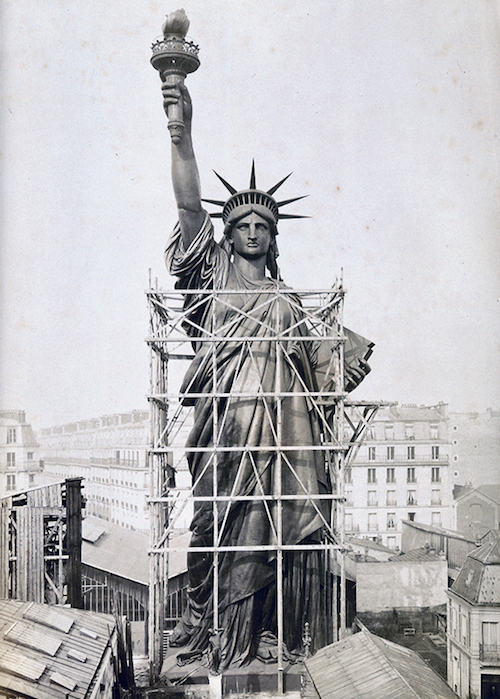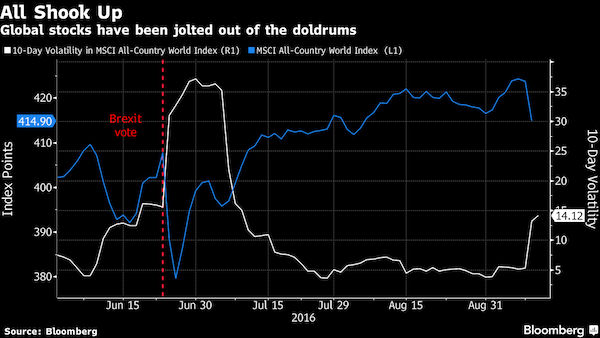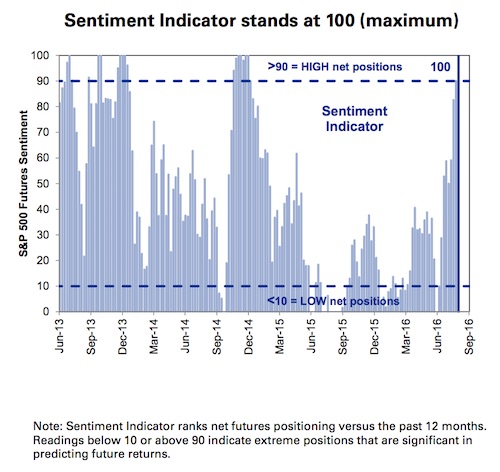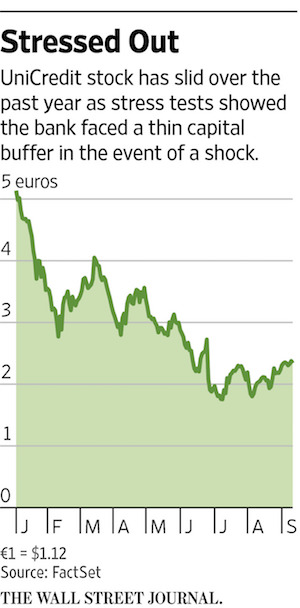
The Statue of Liberty in Paris, outside Bartholdi’s workshop 1884

Whenever I bring up something Hillary Clinton has done or failed to do, there are always people who react with a “Yes, but Trump did so and so…!” reflex. I’d like to get that out of the way first of all, because it distorts the conversation to no end. Criticism of Hillary does not equal support for Trump. Suggesting that it does is insulting.
I do not think it’s a good idea for Trump to become president. But that does not mean it’s a better idea for Hillary to be inaugurated. In fact, there’s something to be said for the argument that if you have to choose between two really bad options, pick the worst in order get it over with faster. The problem with that, in turn, is that in this case it’s hard to determine which of the two is worse.

I’ve had an article in progress on my desktop for weeks, with the (work-)title “Hillary Is Not Electable”. Never finished it until now because there was always 1) lots of work on other things, and 2) a daily stream of new Hillary files that looked like they should be included (I have dozens of them open in a browser).
But then over the weekend, just after I had asked readers of the Automatic Earth Facebook page what they thought the odds were that Hillary would drop out of the presidential race citing health factors, I saw Scott Adams, of Dilbert fame, tweet: “Hillary Clinton just became unelectable”, in reaction to the statement by her campaign that she had become ‘overheated’ during the 9/11 service in NY, where multiple sources report it was about 75ºF (24ºC) with a 40-45% humidity.
Scott didn’t yet know when he wrote his tweet and subsequent blogpost, The Race for President is (Probably) Over, that the ‘official’ message would be changed from overheating to pneumonia mere hours later.
And even though it’s a valid question to ask why she would venture among the public with a potentially -highly- contagious disease that she was diagnosed with two days earlier, and even though I saw my headline used by someone else, these things are not what shapes the issue as I see it. Because I think Hillary became unelectable long ago. Still, then this morning I read the following in the NY Post:
“Clinton’s spokesman said that in addition to her illness, “several of the senior staff have been afflicted with something or other for the last few days.” “I was sick for a couple of days. I had the mild form of it,” Fallon said. The stricken staffers included campaign manager Robby Mook, and two top aides who needed emergency medical treatment – one of whom was taken by ambulance to a hospital emergency room after collapsing from severe dehydration, People magazine reported. Fallon told CNN that Clinton’s pneumonia, which she is treating with antibiotics, was “not contagious.”
So her staff is sick enough to require emergency medical treatment, but not for Clinton’s pneumonia, which is “not contagious”. What do they have then (it’s obviously contagious), and does Hillary have it too, in addition to her pneumonia? Were the staff coughing? The NY Times claimed yesterday that most of the staff were not told about the pneumonia diagnosis. Apparently not even after some of them fell ill around the time of that diagnosis?! What a curious story.
One additional thing I think must be mentioned, which I picked up yesterday through Mish, is a timeline of Hillary’s 2016 coughing fits that consists of 7 examples – with videos- dating back to January 25. We can only guess what’s going on here; the campaign certainly hasn’t been very forthcoming with information.
It’s her very campaign leaders, and the way they deal with information, that have now become Hillary’s Achilles heel. Not that I see how they could have done much else, or much different; whenever someone suggests that Hillary should be fully transparent from now on in, I think 1) you haven’t been paying attention, and 2) transparency is her worst enemy.
Transparency is the very thing she and her crew sought to prevent when setting up her email servers the way they did (in 2009). She recently said it was done at the suggestion of Colin Powell, who promptly denied it, and added that the server set-up had been running for a year before she ever asked him anything about it.
I don’t have a clue why she had the whole thing set up the way she did, it all looks really clumsy, but I do know her initial goal was to expressly be non-transparent. This is obvious from the lack of communication with the State Department. It’s obvious because she deleted 10s of 1000s of emails, many after having received subpoenas (one in August 2013, the other (actually 2 separate ones) in March 2015, forbidding her to do just that.
She did hand over some emails to the FBI and the Benghazi Committee, but thousands more were discovered or handed over at later points in time. Thousands of others were “BleachBit-ted” by an employee of her server host because they allegedly only contained yoga and/or wedding related topics. Not that we can check that; that’s were BleachBit comes in.
The narrative that a lowly employee decided on his own to make these mails unrecoverable is one of the worst points in the entire story. But even more important is that deleting the mails was against US law. And that Hillary and/or her staff are not the people who decide what is important or not. Not when it comes to State business. That is a gross and illegal overreach.
And it’s also what the whole ‘unelectable’ thing hinges on. After 8 years as First Lady and 4 as Secretary of State, it’s fully unbelievable that Hillary would not have known why the State Department has its own servers (though they may not always have functioned in ideal ways), or what classified markers are on mail or email. That reeks of desperation, pre-conceived or not, and it’s ludicrous that the FBI takes her word for it. Moreover, she’s on record saying she’s aware of classification requirements:
@Darren32895836 @Benross75 @jaketapper and here when she says she is well aware of classification requirements: pic.twitter.com/K1KYr9dref
— CR Legal Funding (@crlegalfunding) September 4, 2016
The very moment a high-ranking government official with daily access to classified material sets up a poorly protected email server, in order to bypass government systems, then runs classifies government mail over that server, and subsequently denies having knowledge of what makes material classified, that official is no longer electable. That person is not even employable anymore by the government.
Hillary’s private mail system was vulnerable to hackers. And it did get hacked by Guccifer, albeit, far as we know right now, via a workaround, through the mail of friend of the family Sidney Blumenthal. The irony about that is that Obama and Rahm Emanuel’s refusal to bring Blumenthal into Hillary’s team at State may well be the very reason she set up the private server to begin with (history will tell). Hillary loves Sidney. He’s her guru.
When she last week repeated that her system had not been hacked, that was at best half-true. And half-true is not nearly good enough when it comes to classified state secrets, of which the State Department handles possibly even more than the Oval Office. What we know is that her correspondence with Blumenthal was hacked, what we are not sure of is whether her server itself was hacked. But given that servers around her, DNC et al, were hacked, it would be naive to presume offhand hers was not.
And naive is not good enough, not on our part but even much less on Hillary’s. She’s unelectable because she’s far too much of a liability. That didn’t only become apparent when her knees buckled on Sunday, it became apparent when ‘we’ first found out she used a private server to conduct government business. Or, rather, it became apparent before we found out, it became apparent when she established the system, in January 2009.
There have been too many ‘instances’ and ‘incidents’ to mention, or even to remember. One paragraph I wrote down 10 days or so ago after yet another FBI ‘interview’ came out, summarizes a few:
According to Hillary, she doesn’t remember security briefings due to a concussion and a blood clot after a fall in 2012, she didn’t know what email classification details mean (what’s that ‘C’ for?), she lost 13 Blackberry’s – many with sensitive info on them- (aides took sledgehammers to some they did manage to locate), a MacBook and a thumb drive, she left her email systems open to hackers, she didn’t think communications on drones were -or needed to be- classified, she had her server wiped AFTER receiving a subpoena that expressly said she couldn’t, etc etc.
And that is without mentioning the questionable roles she played in Libya, Honduras and many other places. It’s without acknowledging how her campaign took over the DNC to the extent that they threw out Bernie Sanders. It’s without mentioning the shady goings-on at the Clinton Foundation and between this Foundation and the State Department. It’s also without mentioning what will yet come out of the many 1000s of mails that are due to be released by FBI, State and WikiLeaks, either before or after Nov. 8.
Hillary became a liability to the US, its government and its military- and secret service personnel, a long time ago. And people in the highest offices can and must be held to higher moral standards than others. Because they are responsible for the well-being, the survival and the very lives of so many others.
Step 1 in living up to those standards is to NOT bypass government laws and regulations and systems, without asking explicit permission and being fully transparent about it. Subsequent steps are easy for everyone to think of. Or else, an individual would explicitly declare themselves bigger than the government, and the nation. And that’s what Hillary did: she went rogue.
Ironically, Hillary’s health only became a real issue when she told the FBI she couldn’t remember lots of things, something that was echoed, by the way, in earlier revelations from campaign team staffers that said she tended to forget all sorts of stuff.
The relevance of yesterday’s health episode is not that it made her unelectable, but rather that it might have finally convinced enough of her financial backers that they risk losing the capital invested in ‘their’ candidates’ campaign. She’s their liability now too. I’ve seen people suggest that Trump is throwing his campaign as a way to help Hillary, but I sometimes think it may well be the other way around.
It’s kind of hard to imagine, looking back, for someone to run a worse campaign than Hillary has, but then that’s obvious when you look at how many things had to be kept hidden, how many lies had to be told, how many narratives had to be spun. It just got to be too much, for her, and for the staff. The outcome was always predictable, but they figured they could get away with it.
Thing is, even if she does manage to be elected, someone somewhere sometime will sue her or write about her or blackmail her. That’s a sure thing, and that makes her a massive risk and liability for the Democratic Party, and for the US government as a whole, and for all those multi-million dollar donors to the Clinton Foundation and to her campaign.
As of today, there are exactly 8 weeks left till the election. The money guys better come up with an alternative, because Hillary can’t be president. Whether they will come with Bernie Sanders or Joe Biden or some outsider I don’t know, but they better start making up their minds.
It all looked so promising before the details started leaking out, didn’t it? Destiny, first woman president, all of that. But not this woman. One thing that speaks for Hillary is she screwed it up all by herself. Trump had nothing to do with it. Let alone Putin. In that sense, she’s an independent woman.
In the end, Hillary got stuck in her own web of sheer hubris.












